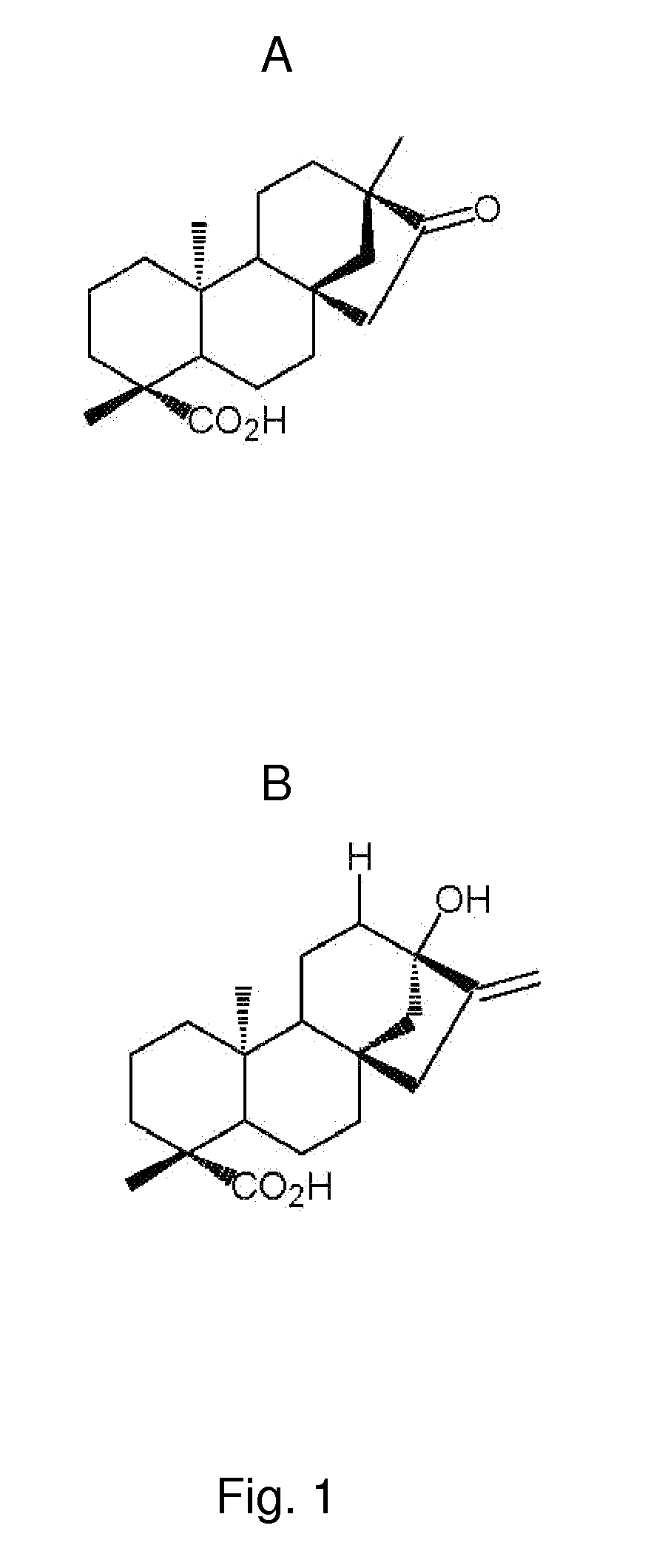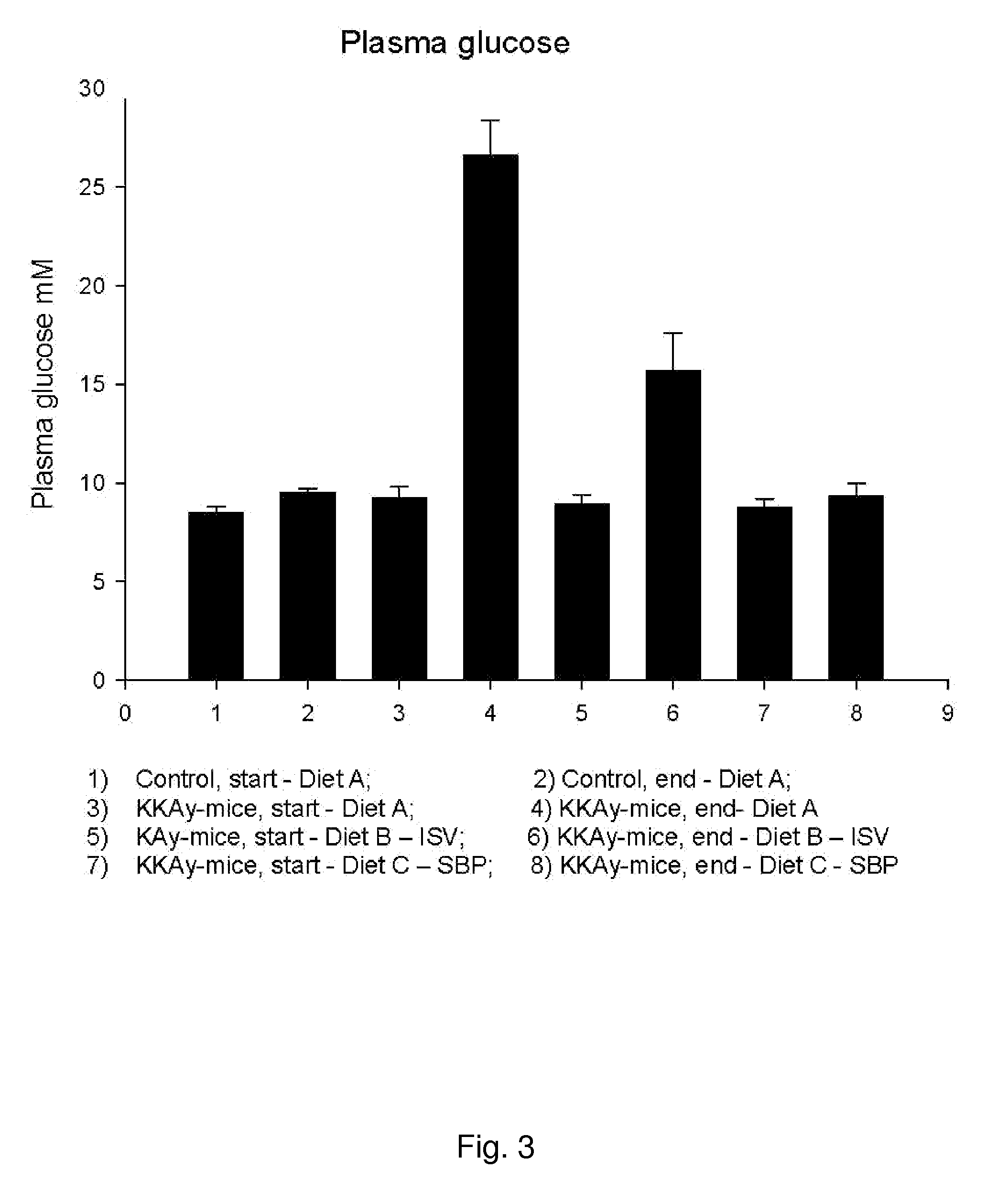Treatment of insulin resistance or diseases associated with insulin resistance
a technology of insulin resistance and disease, applied in the field of treatment of insulin resistance or diseases associated with insulin resistance, can solve the problems of degrading the insulin secretion capacity, inability to absorb glucose, and insufficient normal amounts of insulin
- Summary
- Abstract
- Description
- Claims
- Application Information
AI Technical Summary
Benefits of technology
Problems solved by technology
Method used
Image
Examples
example 1
In Vivo Study of Plasma Concentrations of Insulin, Glucose and Triglycerides in Mice After Administration of Isosteviol or Soybean Protein
[0144]The following experiment was performed to investigate the effect of isosteviol (ISV) and soybean protein on plasma concentrations of insulin, glucose and triglycerides. Four experimental groups, each consisting of 10 KKAy-mice (obtained from Clea Japan, Tokyo, Japan) and one control group of 20 C57 mice (obtained from Taconic, Ry, Denmark), all 5 weeks old, were feed the following three test diets in a period of nine weeks.[0145]A: standard chow diet (SCD)(ALTROMIN 1320, Brogaarden, Hørsholm). Diet A was fed to one experimental group and to the control group.[0146]B: standard chow diet (SCD) (ALTROMIN 1320, Brogaarden, Hørsholm)+0.02 g / kg BW of ISV (Waco Chemicals, Osaka, Japan).[0147]C: diet containing 50 weight-% standard chow+50 weight-% Soybean Protein (SBP) (NutriPharma, Oslo)
[0148]Hormones and lipids were measured from blood sample at ...
example 2
Gene Expression in Islets from Diabetic KKAy-Mice
[0160]As it is thought that the insulin pathway can have relevance in the development of insulin resistance, the expression pattern of a number of gene involved in the insulin pathway or otherwise related to insulin resistance have been examined in islets from diabetic KKAy-mice, after stimulation with isosteviol (ISV) and soybean protein (SBP). Such genes are furthermore candidate genes for identifying individuals at risk for the development of insulin resistance or to develop new pharmacological agents. At present there are few reliable methods for presymptomatic diagnosis of a genetic predisposition for e.g. type II diabetes. Therefore, the present invention also enables the design of genetic based tests for predicting and detecting the onset of insulin resistance.
[0161]Protocol
[0162]A the end of the nine week period of the in vivo study in example 1 RNA was purified from Islets, muscle, liver and fat from the three experimental gr...
example 3
In Vivo Study of Plasma Concentrations of Insulin, Glucose and Triglycerides, and Effects on Gene Expression, After Administration of Isosteviol to Mice
[0198]The aim of the following experiment was to investigate the beneficial effects of isosteviol on the metabolism by investigating the effect of isosteviol (ISV) on the plasma concentration of insulin, glucose and triglycerides, and on body weight. The experiment furthermore investigated the long-term effect of isosteviol on the gene expression profile of key insulin regulatory genes in islets, i.e. the long-term effect of isosteviol on insulin resistance.
[0199]Materials and Methods
[0200]Animals:
[0201]Twenty six male KKAy-mice (Clea Japan, Tokyo, Japan), all 5 week-old, weighing 22-25 g were randomized to 2 groups and treated for 9 weeks with;[0202]A: standard chow diet (control);[0203]B: standard chow diet+20 mg / kg BW of Isosteviol (hereinafter ISV).
[0204]The composition of the standard chow diet dry matter was: Protein 24%, carbo...
PUM
| Property | Measurement | Unit |
|---|---|---|
| Mass | aaaaa | aaaaa |
| Mass | aaaaa | aaaaa |
| Mass | aaaaa | aaaaa |
Abstract
Description
Claims
Application Information
 Login to View More
Login to View More - R&D
- Intellectual Property
- Life Sciences
- Materials
- Tech Scout
- Unparalleled Data Quality
- Higher Quality Content
- 60% Fewer Hallucinations
Browse by: Latest US Patents, China's latest patents, Technical Efficacy Thesaurus, Application Domain, Technology Topic, Popular Technical Reports.
© 2025 PatSnap. All rights reserved.Legal|Privacy policy|Modern Slavery Act Transparency Statement|Sitemap|About US| Contact US: help@patsnap.com



